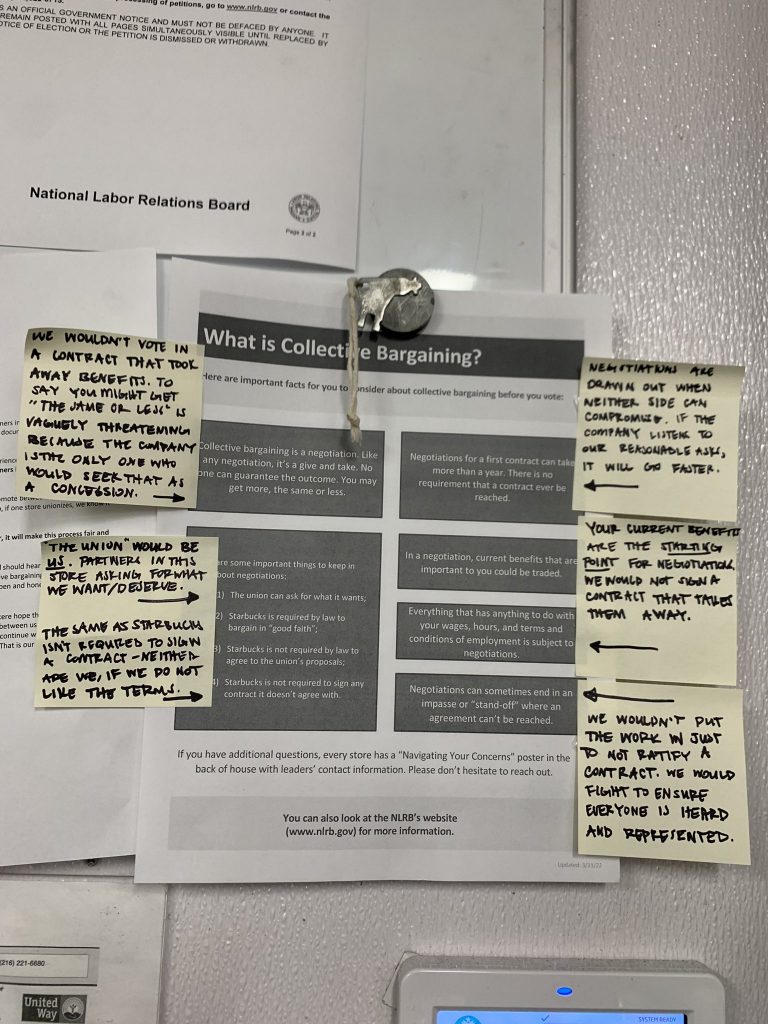On January 20th, 2022 Starbucks workers at a store in Buffalo, New York voted to unionize. The first Starbucks-owned store in the U.S, to be represented by a union since the 1980s, the win at the Elmwood Avenue Starbucks location set off a flurry of organizing at the company.
With the Elmwood Avenue Starbucks location currently locked in contract negotiations with management, eight other stores having successfully unionized, and petitions filed at an additional 150 Starbucks locations, this moment is being heralded by many as a revival of the labor movement.
As described by Chelsea Cruea, a shift supervisor at a Starbucks location in Cleveland, Ohio who has been a partner since 2017, the organizing efforts at Starbucks locations “has picked up like wildfire and spread around the country.”
Represented by Starbucks Workers United, Starbucks workers at a Cleveland location have told management that while they, as Starbucks Partners, “invest their safety, time, and well-being to serve at the forefront of the customer service industry, and this has been especially true during the COVID-19 pandemic. (However), we do not feel we have been adequately cared for in terms of consistent guidelines or effective safety measures… These experiences have often (led) to burnout, disillusionment, and a feeling that rather than being considered “partners”, we are simply cogs in a machine. …we know we can all do better.”
Learn more about the wave of unionization as it hits the non-profit realm.
Cruea’s store announced their intent to file an election petition on February 18, 2022, a month after another Starbucks location down the street did. When she and the other Starbucks partners at the store heard that the location down the street had filed to unionize, they realized that they “could actually do this [too]”.
Facing retaliation and union-busting efforts from Starbucks
Like many other Starbucks locations, Cruea and her colleagues have faced retaliation by the company during their unionization campaign. While no employee has been terminated as of yet, which has been documented at other locations, workers at her location have been the victim of union-busting tactics, such as captive audience meetings, reduction of workers’ scheduled hours, delay tactics, and being ‘iced-out,’ or ignored, by management. Captive audience meetings are held during employee’s work hours by management in order to spread misinformation, pressure employees against unionizing, and interrogate workers about their organizing campaigns. Starbucks has been heralded as organizing one of the most intense union-busting campaigns in decades, in particular because of their use of captive audience meetings as an intimidation tactic.

The hour cuts, specifically, have harmed workers, especially as workers’ access to benefits are tied up with working an average of twenty hours a week. Not only do Starbucks workers depend on their hourly wages to be able to afford living expenses, but many employees, especially their transgender employees, wanted to work for Starbucks in order to access health insurance. If workers are scheduled for less than twenty hours a week on average, they no longer qualify for insurance.
In addition, workers at Cruea’s location have been targeted for posting and talking about the union on social media during their work hours and sharing information about the benefits of unionization via posters in the employee break room. While workers’ posters were removed based on a vague anti-solicitation company policy, anti-union posters by Starbucks management are posted throughout the store.
At first, Cruea’s co-workers took a creative approach to counter the misinformation about unions and added sticky notes debunking the information on the anti-union posters, but those too were removed by management.
Forcing the vote after delay tactics
Cruea’s store is currently “playing the waiting game” and their vote has been met with the delay tactics that have been seen at other stores.
Companies engage in delay tactics because it gives them more time to hold captive audience meetings and engage in misinformation campaigns which are crafted to persuade workers to vote against unionizing. “The longer it takes for us to get a vote, the more time they have to convince us not to,” said Cruea.
In particular, the company has filed motions at other Starbucks locations that have filed to unionize, arguing that individual stores should not be able to be a viable bargaining unit, and that union elections should happen at a regional, not individual, level. The National Labor Relations Board (NLRB) has consistently rejected that argument.
Solidarity between Starbucks workers
Cruea’s store just went through a hearing with the NLRB where they were required to give testimony on why they were organizing their store as a bargaining unit, instead of as a region. “Every store has its own needs…,” Cruea explained, “you feel like you’re fighting for your family.”
Her store is still waiting to receive the NLRB’s decision on this matter, but are expecting that the NLRB will reject the company’s motion that a store is not an appropriate bargaining unit, as they have in previous cases.
Despite the intimidation and delay tactics they have been met with, Cruea and her Starbucks partners feel closer to each other than ever. “Starbucks has always said ‘we’re a family, we’re partners, we’re in this together,’ but we’ve never felt as much togetherness as we have since we started this unionization campaign,” she said.
While they are still waiting to move forward with their unionization process, Cruea and her partners have begun to draft the initial contract they are planning to negotiate for. Their top priority is ending Starbuck’s at-will employment at their store by instituting a just termination clause. Currently, the company can terminate an employee for basically any reason.
By adding a just termination clause agreement, it would ensure that employees wouldn’t be able to get terminated or reprimanded without having a union representative present to negotiate for you and fight for your labor rights. In addition to the just clause, Cruea’s store will be negotiating for better hours, better pay, and better access to the benefits that Starbucks provides.
A path forward for Starbucks Unionization
Each successfully unionized store will draft and negotiate their own individual contracts with Starbucks management based on their particular store’s needs; however, contracts are expected to share many of the same provisions. As a result, labor organizers are anticipating that wages, benefits and working conditions will be improved and strengthened across the sector.
Cruea and other Starbucks organizers remain optimistic about this surge in organizing and the positive impact they’re anticipating it will have on workers. Others, including the NLRB’s own union, have voiced their concern relating to what strain this movement may be putting on a government agency which is over-capacity and underfunded. In particular, some are concerned whether the NLRB is able to successfully investigate and enforce existing labor law, especially in a timely manner, with its caseload increasing.
In order for this revitalization of the labor movement to be successful, agencies like the NLRB have to be able to accommodate the increased need of workers who are filing petitions to unionize and charges against companies for alleged labor violations. When workers are not able to have their labor rights protected and enforced by government agencies, companies are more likely to not comply with labor regulations.
If agencies cannot respond to worker’s needs in a timely manner, corporations have more time to delay unionization campaigns, propagate anti-union misinformation, and retaliate against workers without consequence. In addition, some are concerned that Starbucks, dissatisfied with acting Chief Executive Officer (CEO) Kevin Johnson’s response to its workers’ unionization efforts, has decided to re-instill former Starbucks CEO Howard Schultz as its interim CEO.
Schultz is well known for being anti-union and, even before the announcement of his return as CEO, published an open letter penned to the Buffalo store in response to their unionization campaign. Starbucks Workers United responded to the news of Schutlz’ return on April 4th, 2022 by releasing the following statement: “We encourage Howard Schultz, who has been a leader of Starbucks’ anti-union campaign, to put union-busting behind him and embrace Starbucks’ unionized future.”




